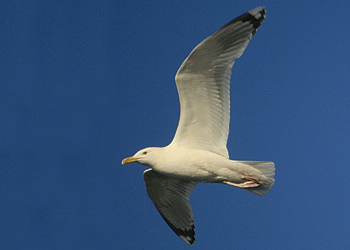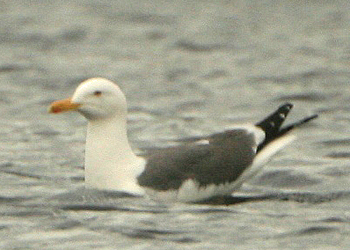 Heuglin's Gull (L. heuglini / antelius)
Heuglin's Gull (L. heuglini / antelius)
(last update:
Amir Ben Dov (Israel)
Chris Gibbins (Scotland)
Hannu Koskinen (Finland)
Mars Muusse (the Netherlands)
adult heuglini: December

Coastline of Russkii Zavorot
peninsula, looking east. Water and wetlands dominate
this tundra, where thousands of karst and lagoon lakes with connecting channels allow
'West Siberian Gulls' Larus heuglini antelius to nest on isolated areas of land.
Phenotypic variation in adult Heuglin's Gull in Israel - just too many odd birds?
The most extensive research on heuglini so far has been done by Valery Buzun, in arctic Russia on the Russkii Zavorot peninsular. His findings are published in British Birds (BB 2002), a copy of that text, tables and images can be found HERE ON THE SITE. Valery's work is right from the heartland of heuglini (called antelius in his article) and should be the norm for what heuglini should look like regarding phenotypics. Interestingly, ornithologists who visit or live in the wintering range of heuglini in the Middle East or east Africa may see birds not completely matching the picture set up by Buzun. Is heuglini much more variable than first thought? Are other breeding populations involved? This is a first and certainly not last step to answer these questions.
Buzun's research in N Russia.
First a short list of the findings of Buzun in northern Russia.
1. Grey tone. Between Kanin and Ob, the grey tone gets slightly paler, with darkest birds in the west (Kanin: Slate grey Ridgway 12.2) to the east (Ob: Dark gull grey Ridgway 9.6). Population range is Deep gull grey 8 - Slate colour 13. This data has been transfered into Kodak Grey colour, used in most field guides. Klaus Malling Olsen & Hans Larsson in Gulls of North America, Europe and Asia write: Adult {antelius}: Almost indentical to Lesser Black-backed Gull race graellsii. Upperwing dark slate (Kodak Grey Scale 8-11), with blacker primaries.
From the same authors: L.f. graellsii: Upperparts pale slate-grey (Kodak Grey Scale 8-10(11))... L.f. intermedius: grades into graellsii, but in darkest birds upperparts blackish-grey to sooty-grey (Kodak Grey Scale 11-13), gaining slaty, or in darkest birds brownish tinge to wear. In general the upperpart grey tone of antelius matches graellsii in a large way, intermedius is darker than heuglini.
2. Primary pattern. In heuglini sub-terminal black on primaries normally to P4 or even P3; only 5% has black on P10-P5.
3. On the underside of P10, the short tongue is normally white (very close to or matching the white underwing primary coverts). 70-75% of antelius have a white or whitish base of the internal web of P10; in 25-30% of individuals, this base is grey.
4. Much black on the outerwebs of outer primaries. Moving descendently from P10 in the half-open wing, the grey portion of the outerweb first becomes visible (projecting beyond the tips of the primary coverts) between P7 and P5 on 55-60% of individuals.
5. Mirrors on P9 and P10. For heuglini, the common pattern is P9 without a mirror and P10 with a complete sub-terminal band and the mirror reaching the edge of the feather. (in Buzun's research: open mirrors).
6. Iris speckling. About 1/3 of individuals have pale eyes (dark speckles in the iris cover <5% of the total area).In the other 2/3, the iris has patches of grey, black or, occasionally, brown pigment. Pigmentation covers about 20-25% of the iris.
7. The orbital ring of about 80% of antelius is dark (coral-) red.
8. In about 92% of individuals the legs are yellow.
9. Adult antelius has a yellow bill with a red-orange subterminal spot on the lower mandible. About 22% has a small black smudge or black band on the bill in summer.
10. Primary moult commencement is between 20 June-20 July. By mid July, about 25% of breeding heuglini from the islands has moulted P3, while 30% of the tundra breeding heuglini has moulted P4 or even higher by mid July. Additional data from Visa Rauste (1999, heuglini in Archangelsk, NW Russia) show late moult by early-September: few birds even with 9 old primaries, most birds with 7 old primaries.
Additional features:
11. Structurally heuglini is typically more elegant with smaller head, slimmer, often droopy bill and longer legs than western taxa. For example, frequently the jizz of heuglini is comparable with Caspian Gull L. cachinnans, but not all are like this. Measurements and bill dimensions vary between sexes and individual variation in absolute size and relative structure cause extensive overlap between LBBG taxa. General structure and jizz are also variable to mood and temper.
12. Gibbins (2004) mentioned adult heuglini to have dark markings on primary coverts more frequently than graellsii, although many birds also show perfectly plain grey greater primarey coverts. So far, there is no research on adult heuglini that really quantifies this feature.
13. Winter head streaking in heuglini seems to be concentrated in the lower hind-neck.
Heuglini in the Middle East
Amir Ben Dov, who is one of the best bird photographers in Israel, concentrates on gulls, including heuglini, for several years now. In his country heuglini is both a winter visitor and a common migrant; he gets migration birds wintering further south on the east coast of Africa and birds on migration to the Arabian peninsular. From a view on the map, you may expect he will get the darkest birds from the western populations of heuglini. Many of his images show classic heuglini, which nicely match the description of Buzun. But a substantial portion of his birds look different. They have either very advanced moult, long pale innerwebs on the underside of P10, black on the outerweb of P8 not reaching to the primary coverts, a large mirror on P10 which merges with the white tip, or a very large mirror on P9.
If these odd features cumulate in a single bird, one may wonder if such a bird really should be called heuglini? Is it really from the N Russian tundra where Buzun described this taxon?
Buzun's samples are not really large, so he may have missed a (small) part of the individual variation of heuglini. But on the other hand, his samples were large enough to make robust conclusions. Individual variation may be slightly larger than what has been described so far, but it is worth to look for alternative populations from which birds may turn up in Israel. Such an alternative population exists.

Heuglini breeding and winter grounds. The green spot is the colony of Ivanovo Oblast. This location holds colonies where large white-headed gulls show various phenotypics within single colonies. Some birds strongly resemble cachinnans in upperpart grey tone, head and bill shape, wingtip pattern and call, while other birds strongly resemble heuglini or barabensis.
Below: marshes, reedbeds, open waters, sand banks... This is the habitat near Selitba (53.10 N) home of the large white-headed gulls of Ivanono Oblast, something completely different from the arctic tundra (68.58 N) where Buzub scored his heuglini (picture: Sergei Potapov).

For several years, another ornithologist Greg Neubauer has been ringing large white-headed gulls in the Ivanovo oblast, Russia (53,10 N). This location holds a gull population with large individual variation in phenotypes. Some birds strongly resemble cachinnans or argentatus in upperpart grey tone, head and bill shape, wingtip pattern and call, while other birds strongly resemble heuglini or barabensis. Below a small selection of pictures, all by Greg Neubauer, to illustrate how variable these birds are. Captions give the 'probable species', nothing is conclusive.
In the vast steppe belt of central Russia there are many many fresh water lakes and apperently some hold colonies with mixed populations. From the Greg's images it's not difficult to imagine birds exist that "very much resembling taxon A, but show single odd features".
One of the odd features surely will be moult timing. The Russkii Zavorot peninsular
lies on 68.58N, and breeding season starts late. Flight distance from the Russkii Zavorot peninsular to Israel is about 4250 km. Compare this to Ivanovo Oblast on 53.10N and a flight distance of only 2400 km. The differences in seasonal condition will be reflected in hatching dates and therefore determine freshness of plumage in juveniles.
The possibility that heuglini-type birds turn up in the Middle East is something to bear in mind. Ivanovo Oblast is perfectly on the route, and ring readings of Greg Neubauer's project already are a fact for Israel (see PVNB, PVSV, and PVPS in Bahrain). These ringed birds may represent the larger group of 'slightly odd heuglini', photographed by Amir in Israel?
 Heuglini
adult, December 06 2010, Maagan Michael, Israel. Picture: Amir Ben Dov.
Heuglini
adult, December 06 2010, Maagan Michael, Israel. Picture: Amir Ben Dov.  Heuglini
adult, December 10 2010, Ashdod, Israel. Picture: Amir Ben Dov.
Heuglini
adult, December 10 2010, Ashdod, Israel. Picture: Amir Ben Dov.  Heuglini
adult, December 24 2010, Ashdod, Israel. Picture: Amir Ben Dov.
Heuglini
adult, December 24 2010, Ashdod, Israel. Picture: Amir Ben Dov. Heuglini
adult, December 31 2010, Ashdod, Israel. Picture: Amir Ben Dov.
Heuglini
adult, December 31 2010, Ashdod, Israel. Picture: Amir Ben Dov. Heuglini
adult, December 25 2009, Ashdod, Israel. Picture: Amir Ben Dov.
Heuglini
adult, December 25 2009, Ashdod, Israel. Picture: Amir Ben Dov.  Heuglini
adult, December 28 2009, Ashdod, Israel. Picture: Amir Ben Dov.
Heuglini
adult, December 28 2009, Ashdod, Israel. Picture: Amir Ben Dov.  Heuglini
adult, December 01 2009, northern Oman. Picture: Hans Larsson.
Heuglini
adult, December 01 2009, northern Oman. Picture: Hans Larsson. Heuglini
adult, December 01 2009, northern Oman. Picture: Hans Larsson.
Heuglini
adult, December 01 2009, northern Oman. Picture: Hans Larsson. Heuglini
adult, December 01 2009, northern Oman. Picture: Hans Larsson.
Heuglini
adult, December 01 2009, northern Oman. Picture: Hans Larsson. Heuglini
adult, December 01 2009, northern Oman. Picture: Hans Larsson.
Heuglini
adult, December 01 2009, northern Oman. Picture: Hans Larsson. Heuglini
adult, December 01 2009, northern Oman. Picture: Hans Larsson. Probable taimyrensis.
Heuglini
adult, December 01 2009, northern Oman. Picture: Hans Larsson. Probable taimyrensis. Heuglini
adult, December 10 2010, Ashdod, Israel. Picture: Amir Ben Dov.
Heuglini
adult, December 10 2010, Ashdod, Israel. Picture: Amir Ben Dov.  Armenian Gull (Right) AE4F0449 Ashdod 3112.10.jpg) Heuglini
adult, December 31 2010, Ashdod, Israel. Picture: Amir Ben Dov. With Larus armenicus.
Heuglini
adult, December 31 2010, Ashdod, Israel. Picture: Amir Ben Dov. With Larus armenicus. Heuglini
adult, December 24 2010, Ashdod, Israel. Picture: Amir Ben Dov.
Heuglini
adult, December 24 2010, Ashdod, Israel. Picture: Amir Ben Dov. Heuglini
adult, December 24 2010, Ashdod, Israel. Picture: Amir Ben Dov.
Heuglini
adult, December 24 2010, Ashdod, Israel. Picture: Amir Ben Dov. Heuglini
adult, December 31 2010, Ashdod, Israel. Picture: Amir Ben Dov.
Heuglini
adult, December 31 2010, Ashdod, Israel. Picture: Amir Ben Dov. Heuglini
adult, December 31 2010, Ashdod, Israel. Picture: Amir Ben Dov.
Heuglini
adult, December 31 2010, Ashdod, Israel. Picture: Amir Ben Dov. Heuglini
adult, December 31 2010, Ashdod, Israel. Picture: Amir Ben Dov.
Heuglini
adult, December 31 2010, Ashdod, Israel. Picture: Amir Ben Dov. Heuglini
adult, December 11 2010, Ashdod, Israel. Picture: Amir Ben Dov.
Heuglini
adult, December 11 2010, Ashdod, Israel. Picture: Amir Ben Dov. Heuglini
adult, December 11 2010, Ashdod, Israel. Picture: Amir Ben Dov.
Heuglini
adult, December 11 2010, Ashdod, Israel. Picture: Amir Ben Dov. Heuglini
adult, December 11 2010, Ashdod, Israel. Picture: Amir Ben Dov.
Heuglini
adult, December 11 2010, Ashdod, Israel. Picture: Amir Ben Dov.










